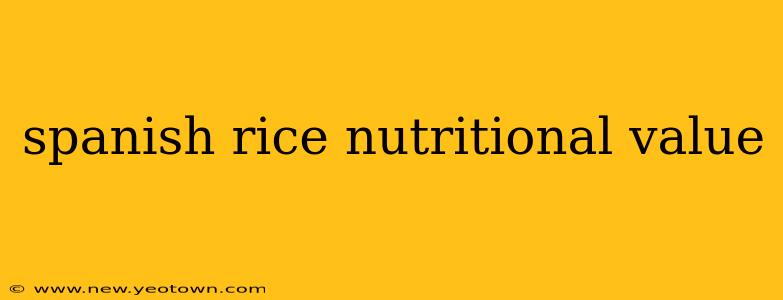Spanish rice, that vibrant and flavorful side dish, is a staple in many kitchens. But beyond its delicious taste, what's the nutritional story behind this beloved recipe? Let's delve into the nutritional value of Spanish rice, exploring its ingredients and uncovering some surprising health benefits (and potential drawbacks).
Imagine this: a warm, fragrant bowl of Spanish rice, its saffron-infused color promising a burst of flavor. But what exactly are you consuming? The answer lies in understanding its core ingredients: rice, tomatoes, onions, garlic, and spices. Each element plays a crucial role, contributing to both the taste and the nutritional profile.
What are the main ingredients in Spanish rice and their nutritional benefits?
The foundation of Spanish rice is, of course, rice. White rice, commonly used, offers carbohydrates for energy. However, it's lower in fiber and micronutrients compared to brown rice. Substituting brown rice can significantly boost the fiber content, promoting digestive health and contributing to feelings of fullness. Tomatoes, rich in lycopene (a powerful antioxidant), add a vibrant color and a dose of Vitamin C. Onions and garlic contribute flavor and offer prebiotic properties, supporting gut health. Finally, spices like saffron (if used) add not only color but also potential anti-inflammatory benefits.
Is Spanish rice healthy? What are the potential health benefits?
The healthiness of Spanish rice depends heavily on the ingredients and cooking methods. A version made with brown rice, plenty of vegetables, and limited added fat can be a surprisingly nutritious side dish. The fiber content, particularly from brown rice, aids digestion and contributes to satiety. The antioxidants from tomatoes and spices combat free radicals, potentially reducing the risk of chronic diseases. However, the nutritional profile can be significantly altered by the addition of excessive fats and sodium.
How many calories are in a serving of Spanish rice?
The calorie count of Spanish rice varies dramatically based on the recipe. A typical serving (around ½ cup) of a traditionally prepared Spanish rice can range from 150-250 calories. However, recipes laden with oil, cheese, or other high-calorie additions can easily push this number significantly higher. Choosing leaner cooking methods and mindful ingredient choices can significantly impact the caloric intake.
How much protein, carbohydrates, and fat are in Spanish rice?
The macronutrient profile also depends on the recipe. Generally, Spanish rice is relatively high in carbohydrates, primarily from the rice itself. Protein content is moderate, mostly coming from the rice and potentially added ingredients like beans or meat. Fat content can vary widely, depending on the cooking method and added ingredients. Recipes with lots of oil will have higher fat content than those prepared with minimal oil or broth.
Does Spanish rice contain gluten?
Typically, Spanish rice does not contain gluten, provided it's made with rice and gluten-free ingredients. However, always check the labels of any pre-made seasonings or broths to ensure they are gluten-free, as some might contain wheat-based additives.
Is Spanish rice good for weight loss?
Spanish rice can be part of a weight-loss diet, but careful consideration of portion sizes and ingredient choices is crucial. Opting for brown rice, loading up on vegetables, and using minimal oil will make it a more weight-loss-friendly option. However, it's essential to monitor portion sizes to avoid excessive calorie intake.
What are some healthier variations of Spanish rice?
To enhance the nutritional profile, consider these healthier variations:
- Brown Rice Spanish Rice: Substituting brown rice for white rice increases fiber and micronutrient content.
- Vegetable-Packed Spanish Rice: Adding more vegetables like bell peppers, zucchini, or corn boosts the vitamin and mineral content.
- Lean Protein Addition: Incorporating lean protein sources like chicken or beans increases the protein content.
- Reduced-Fat Cooking: Minimize oil usage and opt for healthier cooking methods like steaming or baking.
By understanding the nutritional components and making informed choices about ingredients and preparation methods, you can enjoy the deliciousness of Spanish rice while maximizing its nutritional benefits. Remember, mindful cooking is key to a healthy and flavorful culinary experience!

